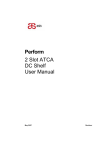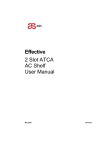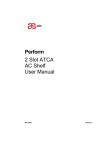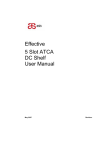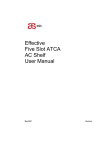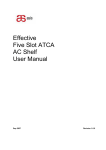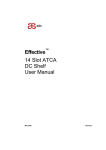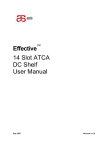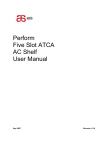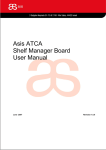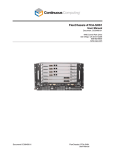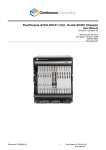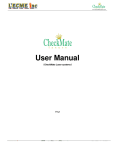Download Effective 2 Slot ATCA DC Shelf User Manual
Transcript
Effective 2 Slot ATCA DC Shelf User Manual May 2007 Revision 1 Table of Contents Table of Contents TABLE OF CONTENTS ................................................................................. II TABLE OF FIGURES ....................................................................................IV LEGAL NOTICE AND WARRANTY ..................ERROR! BOOKMARK NOT DEFINED. ORDERING INFORMATION...........................ERROR! BOOKMARK NOT DEFINED. SAFETY INSTRUCTIONS ........................................................................... VII REVISION HISTORY...................................................................................IX ABOUT THIS DOCUMENT............................................................................. X 1 INTRODUCTION .............................................................................. 12 1.1 OVERVIEW OF ASIS SHELF PRODUCTS ..........................................................12 1.2 EFFECTIVE™ ATCA DC SHELF ...................................................................12 2 UNDERSTANDING THE SHELF COMPONENTS................................... 13 2.1 PLATFORM COMPONENTS ...........................................................................13 2.1.1 Shelf and Boards...........................................................................13 Fixed Board ................................................................................................................ 16 Removable Boards....................................................................................................... 16 2.1.2 Card Cage ....................................................................................16 2.1.3 Backplane ....................................................................................16 Features .................................................................................................................... 16 Update-Channel Connections......................................................................................... 17 Synchronization Clock Interface..................................................................................... 17 2.1.4 Module Slot Identification ...............................................................18 2.1.5 PEM.............................................................................................19 Grounding Requirements and Power Input ...................................................................... 20 2.1.6 Fan Tray ......................................................................................20 2.1.7 Air Filter Tray ...............................................................................21 2.1.8 Blank Panels with/without air baffles ...............................................22 2.1.9 Shelf ID Board ..............................................................................22 2.1.10 Holder for Cable Management (Optional)..........................................23 2.2 SHELF COOLING .....................................................................................24 2.2.1 Overview .....................................................................................24 2.2.2 Fan Tray Design ............................................................................24 2.2.3 Performance .................................................................................25 Effective™ Two-Slot DC ii Revision 1.0.0 Table of Co 2.2.4 Fan Speed ................................................................................... 25 3 INSTALLING THE SHELF .................................................................. 26 3.1 TOOLS REQUIRED .................................................................................. 26 3.2 SITE PLANNING ..................................................................................... 26 3.3 CHECKING PACKAGE CONTENTS .................................................................. 27 3.4 INSTALLATION STEPS .............................................................................. 27 3.5 RACK MOUNTING ................................................................................... 27 3.5.1 Shelf Grounding ........................................................................... 28 3.5.2 Installer Grounding ....................................................................... 28 3.6 SHELF APPLICATION CARD INSERTION .......................................................... 29 3.7 REDUNDANT MODULE INSTALLATION ............................................................ 30 3.7.1 Redundant Shelf Management Card Installation................................ 30 4 MAINTENANCE AND TROUBLESHOOTING ........................................ 31 4.1 PERFORMING PERIODIC MAINTENANCE .......................................................... 31 4.1.1 Fan Tray Visual Inspection ............................................................. 31 4.1.2 Air Filter Cleaning And Replacement................................................ 31 4.2 HANDLING ELECTROMAGNETIC INTERFERENCE ................................................. 32 4.3 EXTRACTING MODULES ............................................................................ 33 4.3.1 FRU Module Extraction .................................................................. 33 4.3.2 PEM Extraction ............................................................................. 33 4.3.3 Fan Tray Replacement................................................................... 33 4.3.4 E²PROM Replacement.................................................................... 34 4.3.5 Third-Party-Module Replacement .................................................... 35 4.4 HANDLING ALARMS................................................................................. 36 4.4.1 Visual Alarms ............................................................................... 36 4.4.2 Software Alarms ........................................................................... 37 4.5 HOT-SWAPPING FRUS ............................................................................ 37 4.6 RESETTING THE SYSTEM .......................................................................... 38 4.7 TROUBLESHOOTING ................................................................................ 39 5 SYSTEM SPECIFICATIONS ............................................................... 40 5.1 CERTIFICATION ..................................................................................... 40 5.2 TECHNICAL DATA ................................................................................... 40 5.3 ACRONYMS USED IN THIS MANUAL .............................................................. 43 Effective™ Two-Slot DC iii Revision 1.0.0 Table of Figures Table of Figures FIGURE 1 – SHELF BLOCK DIAGRAM ..............................................................................1 FIGURE 2 – SHELF FRONT VIEW ...................................................................................1 FIGURE 3 – SHELF REAR VIEW ....................................................................................1 FIGURE 4 – SHELF CHASSIS WITH CABLE HOLDERS .............................................................1 FIGURE 5 - SHELF COMPONENT POSITIONING ....................................................................1 FIGURE 6 – SYNCHRONIZATION CLOCK AND UPDATE CHANNEL PIN ASSIGNMENTS ..........................1 FIGURE 7 – BACKPLANE LAYOUT ...................................................................................1 FIGURE 8 – SLOT ALLOCATIONS ...................................................................................1 FIGURE 9 - SHELF ADDRESSING ...................................................................................1 FIGURE 10 – ATCA 600W DC PEM .............................................................................1 FIGURE 11 –DISTRIBUTION OF POWER ON SHELF ..............................................................2 FIGURE 12 – FAN TRAY .............................................................................................2 FIGURE 13 – AIR FILTER TRAY .....................................................................................2 FIGURE 14 - BLANK BOARD PANEL AND BLANK RTM PANEL ..................................................2 FIGURE 15 - SHELF ID BOARD WITH TWO E²PROMS (REAR COVER REMOVED) ...........................2 FIGURE 16 - FAN AND AIR FILTER TRAYS .........................................................................2 FIGURE 17 - REAR GROUNDING SCREWS .........................................................................2 FIGURE 18 - FRONT ESD SOCKET ................................................................................2 FIGURE 19 – SHELF AIR FILTER EXTRACTION ....................................................................3 FIGURE 20 – EXTRACTING A FAN TRAY ...........................................................................3 FIGURE 21 - E²PROMS ............................................................................................3 Effective™ Two-Slot DC iv Revision 1.0.0 © ASIS Ltd. 2007 Legal Notice and Wa Deleted: e © ASIS Ltd. 2007 Legal Notice and Warranty Information in this document is provided in connection with Asis products. no licens express or implied, by estoppel or otherwise, to any intellectual property rights is gra by this document. except as provided in Asis terms and conditions of sale for such products, Asis assumes no liability whatsoever, and Asis disclaims any expressed o implied warranty, relating to sale and/or use of asis products including liability or warranties relating to fitness for a particular purpose, merchant ability, or infringeme any patent, copyright or other intellectual property right. Deleted: ¶ Deleted: ¶ Asis warranty will be for the quality of the Asis Effective 2-Slot ATCA DC Shelf for a p of one year after the shipment of the product. Asis may make changes to specifications and product descriptions at any time, witho notice. ASIS © Ltd. 2007 Effective™ Two-Slot DC v Revision 1.0.0 Contact Information Contact Information Formatted: DescriptionA Formatted: ItemA Deleted: ¶ Field Code Changed in order to retrieve further information about any of Asis products either described in th document and/or related systems and/or components, please contact an ASIS representative at: Deleted: .co.il Formatted: ItemA Deleted: Headquarters Asis Headquarters Deleted: 3 Galgalei Haplada St. Formatted: Font: (Default) Verdana, 10 pt, Bold, Font color: Auto, Complex Script Font: Times New Roman, 10 pt, Not Bold Kfar Saba, ISRAEL Formatted: DescriptionB, Indent: Before: 2 cm, Adjust space between Latin and Asian text, Adjust space between Asian text and numbers Formatted: Font: (Default) Verdana, Bold, Complex Script Font: Times New Roman, Not Bold Deleted: , Formatted: Font: Bold, Complex Script Font: Not Bold Formatted: Font: (Default) Verdana, Bold, Complex Script Font: Times New Roman, Not Bold 44422 Telephone: +972-73-233-6633 Fax: +972-73-233-6634 E-mail: [email protected] Asis North America 11067 Caminito Arcada San Diego, CA, 92131 USA US toll free: 888 3asisus (888 327-4787) Tel/Fax: E-mail: 858 776-1421 [email protected] See the ASIS web site at http://www.asis-pro.com . Deleted: ¶ Deleted: , USA¶ Formatted: Font: (Default) Verdana, Complex Script Font: Times New Roman Formatted: Indent: Before: 1.92 cm, First line: 0.08 cm Formatted ... [1] Deleted: e Deleted: phone Deleted: Formatted ... [2] Formatted ... [3] Formatted: Indent: Before: 2 cm Deleted: Formatted ... [4] Effective™ Two-Slot DC vi Revision 1.0.0 Safety Instru Safety Instructions This symbol indicates potential safety hazards regarding product operation or maintenance to operator or service personnel. Formatted: ItemB, Adjust space between Latin and Asian text, Adjust space between Asian text and numbers General Safety Practices Before handling the board, read the instructions and safety guidelines on the followin pages to prevent damage to the product and to ensure your own personal safety. Always use caution when handling/operating the board. Only qualified, experienced, authorized electronics service personnel should access the interior of the equipment. The power supplies produce high voltages an energy hazards, which can cause bodily harm. Use extreme caution when installing or removing components. Refer to the installation instructions in this document for precautions and procedures. If you have any questions, please contact ASIS Technical Support. Formatted: Indent: Before: 2.22 cm, Hanging: 0.63 cm, Bulleted + Level: 1 + Aligned at: 2.22 cm + Tab after: 2.86 cm + Indent at: 2.86 cm Always follow the procedural instructions for component removal and replacement in sequence. Power Deleted: ¶ Formatted: ItemB Beware Electrical shock hazard , before any attempt to service the device be su That the device is electrically isolated !!! High voltages are present inside the chassis when the unit's power is plugged into an electrical outlet. Turn off system power, turn off the power supply, and then disconn the power cord from its source before removing the chassis cover. Turning off the system power switch does not remove power to components. Make sure the work environment is grounded, and use a grounding wrist strap when handling the product. ESD Safety Practices Many components described in this document can be damaged by electrostatic discharg (ESD). Follow the precautions described here and before specific procedures in the document to protect static-sensitive components from ESD-related damage. Static electricity can harm system boards. Perform service at an ESD workstation an follow proper ESD procedure to reduce the risk of damage to components. ASIS stro encourages you to follow proper ESD procedure, which can include wrist straps and smocks, when servicing equipment. Effective™ Two-Slot DC vii Revision 1.0.0 Safety Instructions Take the following steps to prevent damage from electrostatic discharge (ESD): When unpacking a static-sensitive component from its shipping carton, do not remove the component’s antistatic packing material until you are ready to install the component in the system. Just before unwrapping the antistatic packaging, be sure you are at an ESD workstation or grounded. This will discharge any static electricity that may have built up in your body. When transporting a sensitive component, first place it in an antistatic container or packaging. Handle all sensitive components at an ESD workstation. If possible, use antistatic floor pads and workbench pads. Handle components and boards with care. Don’t touch the components or contacts on a board. Hold a board by its edges or by its metal mounting bracket. Do not handle or store system boards near strong electrostatic, electromagnetic, magnetic, or radioactive fields. Deleted: ¶ Operating Environment¶ ¶ Temperature ... [5] Formatted: Highlight Effective™ Two-Slot DC viii Revision 1.0.0 Revision H Revision History Number Date Comments Author 1.0.0 May 2007 Initial release Yossi Kuzi Effective™ Two-Slot DC ix Revision 1.0.0 About this Document About this Document This document provides technical information for the Effective 2-Slot ATCA DC Shelf . It is intended for technical staff tasked with installing, setting up and configuring the system, and providing troubleshooting assistance and servicing. Related Documents For information on the Shelf Manager, see the ASIS Shelf Manager Board user manual. Instructions relating to software installation and documentation for application software development for this platform are available in the Shelf Manager External Interface Reference Manual. For Asis product information and additional resources, please visit the Asis website at www.asis-pro.com. Downloads (manuals, release notes, software, etc.) are available via the Technical Support Library product links at www.asis-pro.com (for registered customers). Information about PICMG (PCI Industrial Computer Manufacturers Group) and the ATCA standard may be accessed on the PICMG Web site at www.picmg.com. Formatted: ItemB Chapters and Their Contents 1 Introduction General overview of the product family and Pg. 12 the shelf. 2 Understanding the Describes the shelf and its components, Shelf Components including the boards installed in the shelf: Deleted: “ Backplane, Power Entry Module, Shelf ID Deleted: ” Boards. Describes the cooling capabilities Pg. 13 of the shelf. 3 Installing the Shelf Procedures and precautions involved in Pg. 26 product installation 4 Maintenance And Periodic maintenance, troubleshooting and Troubleshooting diagnostic procedures, as well as module Pg. 31 replacement instructions 5 System Specifications Detailed quantitative information about the Pg. 40 system's dimensions and operational parameters, operation limitations, certification and standard compliance Effective™ Two-Slot DC x Revision 1.0.0 About this Doc Style Conventions Verdana Regular text. Arial Bold Commands, keys and other parts of the user interface. Arial Italics Monospace Names of classes, methods, arguments, exceptions, properties, etc. Also used for special terms, the first time they appear. Text displayed on the LCD or on a computer attached to the product. Notes, which offer an additional explanation or a hint on how to overcome a common problem. Warnings, which indicate potential safety hazards regarding product operation or maintenance to operator or service personnel. Effective™ Two-Slot DC xi Revision 1.0.0 Introduction Overview of ASIS Shelf Products 1 Introduction This chapter includes a summary of the Asis shelf product line and a brief overview of th Effective 2-Slot ATCA DC Shelf. For acronyms used in this document see Section 5.3. 1.1 Overview of ASIS Shelf Products As for ATCA Shelf , ASIS offers two product families : Effective for cost-sensitive, yet demanding applications. Deleted: ance Perform for top-of-the line solutions, for environments in which high levels of performance, availability and reliability are mandatory. 1.2 Formatted: Font color: Auto Formatted: Font color: Auto Formatted: Font color: Auto Effective ATCA DC Shelf The Effective 2-Slot ATCA DC Shelf offers the reliability and availability of the Telco-grade standards in a package, where maximum possible performance (backplane interconnect bandwidth, power levels and thermal capabilities) is provided in the shelf. Every aspect of the Effective 2 slot Series ATCA has been developed to surpass the Formatted: Font color: Auto Current solutions found in the market. The Effective 2 slot ATCA has been developed Formatted: Font color: Auto based on the accumulated knowledge and experience in the implementation of Formatted: Font color: Auto available. It incorporates the latest technologies available to reduce its price while Formatted: Font color: Auto Formatted: Font color: Auto the ATCA standard since its inception in 2001, while incorporating the latest technologie maintaining performance and reliability. The system offers optional redundancy for powe input and management functions. All shelf assemblies are designed using FieldReplaceable Units (FRUs), thus enabling easy and fast field maintenance with Formatted: Font color: Auto minimum or no downtime, availability of 99.999%. In addition, an Asis cable-holder Formatted: Font color: Auto frame can be fitted to both side-mounting flanges of the shelf. Formatted: Font color: Auto The Effective 2 slot Series ATCA is designed to comply with FCC, and CE certification, an with UL, NEBS Level-3 and ETSI. Formatted: Font color: Auto Formatted: Font color: Auto It is fully complies to AdvancedTCA™, PICMG 3.0 R2.0, and IPMI v 1.5. Formatted: Font color: Auto Deleted: . Deleted: ¶ Effective™ Two-Slot DC 12 Revision 1.0 Understanding the Shelf Compo Platform Comp 2 Understanding the Shelf Components This chapter summarizes the functional features of the Effective 2-Slot ATCA DC She and describes in further detail each of the components as well as the shelf system co mechanism. The system was designed to withstand extreme conditions (to meet rigid Telco requirements). It is designed to incorporate Field-Replaceable Units (FRUs), and is fu field-serviceable. 2.1 Platform Components A typical platform consists of the following key components: 19-inch rack mount shelf - Base hardware element of the platform, which holds all the components together. Card cage - Portion of the shelf that holds the modules that are plugge into the backplane. Mechanically compliant with all aspects of PIMG 3.0 Backplane - Supports one or two third-party ATCA-compliant front boards, and the complementary rear transition module (RTM). The backplane provides full-mesh Fabric interface, and direct mating to the PS's and to the redundant Shelf Manager ShMC board. PEM – Redundant, field replaceable. Fan tray - Hot-swappable, provides side to side cooling, and is designe to provide N+1 fan redundancy cooling to components on the front and rear of the shelf. Air filter tray - Keeps the airflow free of dust and particles. Deleted: Airflow Management Blank Panels - For air flow management. Shelf ID Board Formatted: Font: Bold, Complex Script Font: Not Bold Cable management Holders - for Front cable management. Rear connection boards 2.1.1 Formatted Shelf and Boards Figure 1 shows the block diagram of the shelf and figures 2 and 3 show front and rear view the shelf with key components highlighted. Formatted: Bodytext Deleted: See Figure 1 for a block diagram of the shelf, and Figure 2 and Figure 3 for front and rear views of the shelf, respectively.¶ Effective™ Two-Slot DC 13 Revision 1.0.0 Understanding the Shelf Components Platform Components Figure 1 – Shelf Block Diagram Card cage 2-slot backplane ESD Grounding CO i Flange for cable management holder Shelf manager board (front panel) Fan tray Air filter tray Figure 2 – Shelf Front View Rear cover RTM cage Formatted: (Complex) Hebrew, Check spelling and grammar Shelf grounding PEM B Figure 3 – Shelf Rear View Effective™ Two-Slot DC 14 PEM A Revision 1.0 Understanding the Shelf Compo Platform Comp Figure 4 illustrates the use of cable holders: Figure 4 – Shelf Chassis with Cable Holders Figure 5 - Shelf Component Positioning Deleted: availability In order to increase ASIS Effective 2 slot ATCA DC Shelf reliability, and to simplify th shelf’s format, only one of the boards installed in the Shelf has logic circuits in it. All boards and FRU’s are passive. Effective™ Two-Slot DC 15 Revision 1.0.0 Understanding the Shelf Components Platform Components Deleted: Some are fixed boards and some removable Deleted: s Deleted: <#>Shelf ID: this board hosts two SEEPROMs that contain data about the shelf – such as serial number and manufacturer – and about the board’s setup – such as shelf thermal budget and slot population. (see Section 2.1.92.1.9)¶ Only the backplane is a fixed board. Remaining boards are removable: Fixed Board Backplane Removable Boards Shelf Manager board (see the ASIS Shelf Manager Board User Manual). Shelf ID: this board hosts two E²PROMs that contain data about the shelf – such as serial number and manufacturer – and about the board’s setup – such as shelf thermal budget and slot population. Card Cage Formatted: Bullets and Numbering 2.1.2 Deleted: S The shelf’s card cage is composed of: Deleted: s the backplane right and left guide rails to hold the modules that plug into the backplane. The card cage supports two 8U front boards, and two 8U RTMs. The guide rails in the card cage incorporate electrostatic discharge (ESD) clips. 2.1.3 Backplane Features The ATCA PICMG 3.0-compliant backplane provides external interfaces and card connectivity. It conforms to the PICMG 3.0 R2.0 AdvancedTCA Base Specification. Backplane features include: Two slots Fabric interface with full mesh interconnect. The Fabric Interface grid consists of eight differential pairs per channel; The Base Interface grid consists of four differential pairs per channel. Dual-star Ethernet signalling environment on the Base interface. Deleted: is Deleted: . Bussed IPMI (radial IPMI available upon request). Two hub slots. Hub/Node configuration; update channel between slots 1 and 2. Deleted: ¶ 10, 100 and 1000 BASE-T dual star Base Interconnect capability. Updatechannel interfaces for active and standby synchronization, and mesh topology handling up to 5Gbps per differential pair. Connection capacity for up to two third-party ATCA-compliant front boards, as well as to the redundant Shelf Manager and redundant PEM's. Deleted: y Deleted: C Full compliance with AdvancedTCA™ electrical and mechanical specifications (Basic backplane topology is “full mesh”.) Effective™ Two-Slot DC 16 Revision 1.0 Understanding the Shelf Compo Platform Comp Interconnect for system power for two slots. Deleted: and power and control for the fan tray. Base channel 1 allocated for the Shelf Manager Controller. There are no active components on the backplane, and no removable or serviceable on the backplane board. The backplane has two functionally-distinct parts: right and center left: Right backplane (consists of Zone 1 connectors) – dual-power connections, which means the power connections from the two PS's are independently supplied to each module plugged into the backplane. Center-left backplane (consists of Zone 2 connectors) – connectivity for the Base, Fabric, and update-channel interface. This portion supports a full-mesh topology for both the Base and the Fabric interfaces. Update-Channel Connections The update channels are backplane connections between pairs of modules that opera a redundant basis. Application software can use the update channel for redundancy interlock, or to provide a direct connection that bypasses the (indirect) fabric interfac If you configure a pair of modules to use the update channel for redundancy support must insert the two modules into slots linked by an update channel. Comment [y1]: REF?? Figure 6 shows the update channel connections. Each update channel consists of 10 differential-pair connections. If an update channe connects two modules that are not identical, the Shelf Manager disables the update channel between them. Synchronization Clock Interface The backplane supports a set of synchronization clock buses that can exchange synchronization timing information. This synchronization can be used for system-wid intersystem synchronization purposes, which are important in some applications, suc those involving synchronous time division multiplex (TDM). Deleted: Deleted: # Deleted: Row Deleted: # Interface Px20 Connector Pairs ab Deleted: Deleted: Deleted: Deleted: Deleted: Rx4 (UP)- cd ef gh 1 Clks CLK1A+ CLK1A- CLK1B+ CLK1B- CLK2A+ CLK2A- CLK2B+ C 2 Update channel & Clks Tx4(UP)+ Tx4(UP)- Rx4(UP)+ Rx4(UP)- CLK3A+ CLK3A- CLK3B+ C The update channels are routed to adjacent slots. Slot 1 connects to Slot 2. Deleted: Deleted: Figure 6 – Synchronization clock and update channel pin assignments Deleted: Formatted Table Effective™ Two-Slot DC 17 Revision 1.0.0 Understanding the Shelf Components Platform Components Figure 7 – Backplane layout 2.1.4 Module Slot Identification The shelf is compliant with PICMG 3.0 R2.0, and accepts modules compliant with this standard. Figure 8 illustrates the locations of the module slot allocations when viewed from the front. The physical and the logical slot allocations are the same for this shelf: the slots a numbered 1 to 2 from bottom to top. Figure 8 – Slot Allocations The following table shows the hardware addresses in relation to the slot numbers and sl addresses. Slots are shown in the same order as they appear in the shelf: slot 2 above slot 1. Formatted Table Slot Hardware Address Hardware Address Number (8 bit format) (7 bit format) 2 84h 42h 1 82h 41h Figure 9 - Shelf Addressing Effective™ Two-Slot DC 18 Revision 1.0 Understanding the Shelf Compo Platform Comp 2.1.5 PEM The field replaceable, -48 VDC, PEMs provide power to the shelf. The ASIS Effective 2 slot ATCA DC Shelf is equipped with connectors for two redunda hot swappable and field replaceable PEMs. Both PEMs are located in the lower-Back of the shelf, fitting directly into to the backp The DC connectors are located on the rear of the chassis. Deleted: התמונות לא מעודכנות Figure 10 – ATCA 600W DC PEM Effective™ Two-Slot DC 19 Revision 1.0.0 Understanding the Shelf Components Platform Components Deleted: Distribution Figure 11 –Distribution of Power on Shelf Grounding Requirements and Power Input Deleted: The PEMs provide protection for the shelf against EN61000-4-5 surge transients. The PEMs reduce the surge transients to under 100V for a maximum duration of 10µs, and under -200V for a maximum duration of 5µs. Protection against EN610000-4-4 EFT transients is also provided.¶ Formatted: Bullets and Numbering Deleted: When connecting ground and power cables to the shelf, follow instructions in the beginning of this document. 2.1.6 Fan Tray The fan tray is a closed module containing four 80x80mm fans that supply air volume and velocity for cooling the high-density/high-performance computing environment. The cooling power of the four fans can dissipate the heat generated by up to two front boards and complementary RTMs. More than 200W for front board and 15W for RTM, per slot is supported. Deleted: by Three of the fans are dedicated to cooling the front side of the shelf, while the fourth on Deleted: Up to is shared between the front side boards and the rear side I/O equipment. Deleted: The fan tray is designed with N+1 redundancy to meet the cooling requirements of a ful Deleted: Maybe more Formatted: Not Highlight shelf. Effective™ Two-Slot DC 20 Revision 1.0 Understanding the Shelf Compo Platform Comp Deleted: the fan tray must be replaced as soon as possible Deleted: will Deleted: the shelf does not have to be shut down during the replacement. In case of single fan failure, the remaining fans provide the required cooling to dissip the heat generated by the occupied slots. It is recommended to replace the fan tray soon as possible. The fan tray is factory-mounted in the Effective 2-Slot ATCA DC Shelf. It is easily replaceable, and can be replaced while the shelf is operating. For more on shelf cooling, see Section 2.2. Deleted: לא מעודכן Figure 12 – Fan Tray 2.1.7 Deleted: d Air Filter Tray A NEBS-GR63-compatible air filter comes installed on the ASIS Effective 2 slot ATCA Shelf. The filter is field-serviceable, and can be extracted for periodic field maintenan for field replacement. The filter is easily accessible from front right side of the card cage. A shelf-based mic switch detects the installed filter and reports its presence to the Shelf Manager. For instructions on air-filter maintenance, see Section 4.1.2. Figure 13 – Air filter tray Effective™ Two-Slot DC 21 Revision 1.0.0 Understanding the Shelf Components Platform Components Deleted: AirflowManagement 2.1.8 Blank Panels with/without air baffles Compliance with ATCA's temperature specifications requires a steady air flow in the shel To insure a steady air flow, either the ASIS Effective 2 slot ATCA DC Shelf must be fully populated, or a blank panel, available from ASIS, must be equipped to fill every empty slot. The "blank panel" is designed to emulate the air flow restriction in a standard card, thus ensuring the required conditions for proper cooling. Three types of airflow-management panels are available for the empty slots on the shelf These include panels specifically designed for: Deleted: empty blank front module panels, with/without air baffle; Deleted: slots blank RTM panels; Deleted: empty an empty shelf-manager panel slot. Deleted: slots Deleted: ¶צבע לא תואם Figure 14 - Blank Board Panel and Blank RTM Panel Formatted: Normal 2.1.9 Shelf ID Board A shelf ID board containing two redundant field replaceable E²PROM chips is housed in t rear of the Effective 2 slot ATCA DC Shelf. The E²PROMs store product and manufacturer information such as shelf serial number, part number, backplane routing assignment, and shelf heat budget. Deleted: C Deleted: When the Shelf Manager board boots up, it compares the information stored in the two E²PROMs: If E²PROM data coincides, it is loaded and saved in the ShMC Board, and the shelf initializes. In case of a mismatch, the data on the E²PROMs is compared with the last saved configuration in the ShMC Board: Effective™ Two-Slot DC 22 Revision 1.0 Understanding the Shelf Compo Platform Comp If the saved configuration matches one of the E²PROMs it is assum to be the right one and it is stored in both E²PROMs. If the three configurations are all different, the ShMC board will no boot up. Deleted: לא מעודכן Figure 15 - Shelf ID Board with two E²PROMs (rear cover removed) 2.1.10 Holder for Cable Management (Optional) Deleted: As standard, a Deleted: special Deleted: The cable management holder is an optional device, specifically designed to cope with the large number of connecting cables and fibers found in a shelf such as the Effective 2-Slot ATCA Shelf.¶ A cable holder frame can be fitted to both side mounting flanges of the shelf. Cables attached to the cable management holder must be allowed to move freely; Insure that a service loop of minimal required length is maintained. Formatted: Highlight Formatted: Highlight Deleted: ¶ Effective™ Two-Slot DC 23 Revision 1.0.0 Understanding the Shelf Components Shelf Cooling 2.2 Shelf Cooling 2.2.1 Overview ASIS Effective 2 slot ATCA DC Shelf complies with all the cooling requirements specified PICMG V3.x specifications. The cooling system consists of four high-performance fans. The air comes in from the right side and exits through the left side of the shelf. The fault-tolerant design is optimiz for airflow of more than 200W per module. 2.2.2 Fan Tray Design ASIS Effective 2 slot ATCA DC Shelf ventilation is achieved by four 80x80 mm fans, installed in the fan tray. The fans provide for n+1 redundancy. Figure 16 - Fan and Air filter trays The fan tray connects directly to the backplane, where it plugs into power and control connectors. The fan tray unit is front-serviceable, and can be easily replaced without too Deleted: how the fans Deleted: to Formatted: Not Highlight Formatted: Not Highlight Formatted: Not Highlight In order to minimize possible failures, the fan tray does not contain any active electronic components. The shelf management FRU fully controls adjustments of the fans based on temperature changes. Cooling ability is maintained even in the case of a single fan failure. In this case, the gre LED of the fan tray turns red, so that it is easier to identify the tray that needs to be replaced. Deleted: Is this the right way to say it in English? Effective™ Two-Slot DC 24 Revision 1.0 Understanding the Shelf Compo Shelf C 2.2.3 Formatted: DescriptionA, Adjust space between Latin and Asian text, Adjust space between Asian text and numbers Performance The four fans supply air volume and velocity for cooling the high-density/highperformance computing environment. The cooling power of the fans can dissipate th generated by up to two front boards and complementary RTMs. At least 200W per fr board and 15W for RTM per slot is supported. Refrain from clogging air input and exhaust during chassis operation. Deleted: Ensure that the air entering the shelf remains within the specified maximum temperature limit. If the air temperature exceeds the specified maximum, and the fan tray operating at full speed is unable to maintain the FRUs within their recommended temperature limits, the platform could begin to reduce the thermal load, which could reduce platform performance. This response to excessive temperatures protects the modules from physical damage caused by overheating.¶ If the surrounding temperature exceeds the non-operating temperature limit, the platform could shut down system modules in order to reduce thermal load.¶ 2.2.4 Fan Speed When a fan tray is inserted into the shelf, the fans start at full speed and then decre steps of 7%. Under normal operating conditions, the fans run at 21% of full speed. T lower speed reduces the acoustic noise and increases the longevity of the fans. The circuitr the fan trays uses a pulse-width modulation to control the speed of the fans. The speed of each individual fan is monitored. If the speed of any of the fans drops b the desired fan speed, the other fans will speed up to compensate. The Shelf Manage such events in its system event log (SEL) as a fault condition. If this occurs, replace fan tray as soon as possible to restore fault tolerance and redundancy. Formatted: Highlight Formatted: Bullets and Numbering Effective™ Two-Slot DC 25 Revision 1.0.0 Installing the Shelf Tools Required 3 Installing the Shelf This chapter provides you with instructions on how to prepare the Effective 2-Slot ATCA DC Shelf for use. You will be performing some or all of the following setup tasks: Site Planning Checking Package Contents Rack Mounting PEM installation. Shelf Application Card Insertion Redundant Module Installation. Before installing the Effective 2-Slot ATCA DC Shelf, you should be aware of what cables will be needed for equipment and power, and whether they will be connected in the front or rear of the shelf. 3.1 Tools Required To install the shelf in a standard 19" rack, the following tools are required: Standard Philips screwdriver set Wrench ESD grounding bracelet. All the modules in the Effective 2-Slot ATCA DC Shelf are field-replaceable units (FRUs) requiring no special tools for mounting other than those mentioned above. 3.2 Site Planning Only qualified personnel should be involved with this installation procedure. The Effective 2-Slot ATCA DC Shelf can be installed either on a standard 19" rack or as a desk-top unit. All sides of the shelf should be easily accessible. The prerequisites for setting up the Effective 2-Slot ATCA DC Shelf for use in your facility involves: If a rack is used, it should be properly grounded. A readily accessible disconnect device must be incorporated into the building’s wiring between the shelf’s PEM's input terminals and the power source. Effective™ Two-Slot DC 26 Revision 1.0 Installing the Checking Package Co The disconnect device rating required is determined by the nominal inp voltage. To ensure sufficient airflow for the individual blades in the shelf, allow a least two inches of clearance at the side air inlets and outlets. 3.3 Checking Package Contents The following items are included in the Effective 2-Slot ATCA DC Shelf package. Chec that all items in the package are intact. Use of equipment damaged during delivery could prevent proper functioning the Shelf and/or cause permanent damage to it. Check all pins, screws and o components before using any of the package contents. Shelf chassis with backplane Fan tray Air filter tray 1 600W PEM 2 Cable-management holders (optional). 3.4 Installation Steps The following overall procedure is described more in detail in the sections below. Deleted: cable 1. Install the Cable-management tray holder (optional). 2. Mount the chassis in the rack with four screws. Deleted: ss Formatted: Not Highlight 3. Connect the chassis to the site ground with a ground cable. 4. Insert a Shelf Manager board into the right slot. 5. Connect the PEM to a properly Power Supply. 3.5 Rack Mounting You will need four M6x10 (or longer) screws to mount the chassis on the rack. Before you begin: Verify that the transient operating temperature in the area of the rack does not exceed the 55°C maximum, and that the rack has support rail installed. Confirm the rack is stable so that the weight of the shelf does not cause to tip over. Effective™ Two-Slot DC 27 Revision 1.0.0 Installing the Shelf Rack Mounting To mount the shelf on the rack: Two Persons needed to Preform this task. Insert the Effective 2-Slot ATCA DC Shelf chassis on the 19" rack, securing it by fastening the four mounting screws. The shelf should be level, and not positioned at an angle in the rack, and the rack’s doors should be able to close. 3.5.1 Shelf Grounding Connect rear grounding screws on the rear left side to insure that the shelf is properly grounded. Deleted: ¶ Figure 17 - Rear grounding screws 3.5.2 Installer Grounding Any person involved in handling the shelf or card installation or replacement is required to wear an ESD grounding device. One grounding sockets can be found on the shelf: an ESD grounding socket in the front of the shelf Effective™ Two-Slot DC 28 Revision 1.0 Installing the Shelf Application Card In Figure 18 - Front ESD Socket Formatted: Bullets and Numbering 3.6 Shelf Application Card Insertion Third-party application cards must be ATCA-compliant. Application cards should be inserted only after the installation, power-up and testing procedures of the Effective 2-Slot ATCA DC Shelf have been completed. Insert application cards according to the manufacturer's instructions, making sure th are properly-positioned in their slots and are secured to their respective connectors. When an application card is inserted and powered up, the blue LED should switch on light steady for 10-30 seconds (depending on the card type). After that time, the blu should blink for about 10 seconds, and then go off. Each third-party application card must provide a hot-swap LED. This LED can be in o the following states: Indicator Indication State Off The card is not ready for removal or disconnection from the shelf Blue The card is ready for removal or disconnection from the shelf Blinking slowly The card is activating itself Blinking quickly Brief deactivation has been requested Effective™ Two-Slot DC 29 Revision 1.0.0 Installing the Shelf Redundant Module Installation Formatted: Bullets and Numbering 3.7 Redundant Module Installation 3.7.1 Redundant Shelf Management Card Installation The redundant ShMC Board is installed after the shelf has been powered up. Follow the instructions for the first Shelf Management card in the Shelf Manager user manual. Effective™ Two-Slot DC 30 Revision 1.0 Maintenance And Troublesh Performing Periodic Mainte 4 Maintenance And Troubleshooting This chapter includes instructions regarding: Performing Periodic Maintenance Fan tray visual inspection Air filter cleaning and replacement Figure 19 – Shelf Air filter extraction Handling Electromagnetic Interference Extracting Modules Handling Alarms Hot-Swapping FRUs Resetting The System Troubleshooting. Deleted: management As required by the ATCA standard, the Effective 2-Slot ATCA DC Shelf applies a fully swappable approach. Assuming redundancy has been provided for (i.e., two ShMC b units, and two PEM's), all of the shelf assemblies can be field-replaced with no interr to service. Visual alarms provide clear indication of trouble, for easy problem location. Malfunctions can be responded to quickly and easily, as no field repair is necessary. modules can be easily extracted and replaced with no tools or with a minimal set of t 4.1 Performing Periodic Maintenance This section provides procedural instructions on servicing or replacing shelf compone Maintenance of the Effective 2-Slot ATCA DC Shelf involves the following tasks: Fan Tray Visual Inspection Air Filter Cleaning And Replacement. 4.1.1 Fan Tray Visual Inspection The fan trays should be checked periodically for any visible damage that could preve disrupt normal fan operation. See Section 4.3.4 for instructions on replacing a fan tray. 4.1.2 Air Filter Cleaning And Replacement The air filter should be checked regularly. If environmental conditions are good, it m enough to extract the filter and vacuum clean it. Otherwise it might be necessary to replace it. The air filter can be ordered separately (i.e., without the metal tray). Air filter cleaning must be performed in a different location from where the shelf is p Effective™ Two-Slot DC 31 Revision 1.0.0 Maintenance And Troubleshooting The air filter can be extracted without interrupting power. Release the two tumble screw on the front side of the air filter unit and extract the unit by pulling the two tumble screws. Figure 19 – Shelf Air filter extraction 4.2 Handling Electromagnetic Interference The shelf emits electromagnetic waves that may interfere with nearby equipment. Conversely, nearby electronic equipment may emit electromagnetic waves that interfere with the shelf. The EMC, EMI, and RFI specifications of the shelf and all nearby equipme should be considered when choosing the placement of the platform and surrounding equipment. In the shelf and most other equipment, the use of airflow management fillers in otherwise unoccupied slots is necessary to keep the product’s emissions within their specified limits. Install front and rear airflow management fillers into any empty slots. Do not use blank faceplates in place of fillers. Deleted: , leaving no empty slots in the final shelf configuration. Keep slots populated with active modules directly next to each other and fillers directly adjacent to the outermost active modules. If the shelf experiences unexpected and intermittent data errors, carefully consider the possibility of electromagnetic interference from nearby equipment as a possible source of the problem. Identifying and measuring errors caused by electromagnetic interference can be challenging and may require the assistance of engineering personnel with experience in this field. Effective™ Two-Slot DC 32 Revision 1.0 Maintenance And Troublesh Extracting M Deleted: blades If your system configuration does not populate all front slots with active blades, you fill those empty slots with additional blades or slot flow blocker blades to maintain sy airflow and electromagnetic shielding integrity. Blank panels can be ordered separate 4.3 Extracting Modules 4.3.1 FRU Module Extraction To extract an ATCA-compliant FRU module: 1. Pull the module's insertion lever slightly. The de-activation sequence begins. 2. After the module's blue led lights steady, pull out the module's insertion lever. Formatted: Bullets and Numbering 3. Pull out the module. 4.3.2 FRU Module insertion To insert an ATCA-compliant FRU module: 1. Push the module's carefully inside the chassis . 2. The activation sequence begins 3. The blue (hot swap) led starts to light . Formatted: Bullets and Numbering 2. After the module's blue led turn off, the module is active. 4.3.3 PEM Extraction If PEM redundancy is implemented, one of the PEM can be extracted without stoppin service. To extract one PEM: 1. Disconnect the power cables. 2. Release the two tumble screws. 3. Fully pull out carefully the PEM insertion lever. Formatted: Bullets and Numbering 4. Pull out the PEM. 4.3.4 PEM insertion If PEM redundancy is implemented, one of the PEM can be inserted without stopping service. To insert a PEM: 1. Push in the PEM 2. Fully push in the PEM insertion lever. 3. tighten the two tumble screws back in to place. Effective™ Two-Slot DC 33 Revision 1.0.0 Maintenance And Troubleshooting Extracting Modules Formatted: Bullets and Numbering 4.3.5 Deleted: . The shelf should be used only with a fully-operational fan tray. A malfunctioning fan tray should be replaced immediately, in order to prevent thermal damage to the installed application cards. Fan Tray Replacement Use care when handling the fan trays, and do not handle them from the connectors. Improper handling of the fan trays could cause damage to the connector pins. Do not handle a fan tray while the fans are operating. To replace the fan tray: 1. Without interrupting power, release the two tumble screws on the front side of the fan tray. 2. Extract the tray by pulling at the handle, as shown below: 3. Insert the replaceable fan tray unit. Formatted: NumList A 4. Push each of the two thumbscrews in and tighten. Figure 20 – Extracting a Fan Tray Formatted: Normal Formatted: Bullets and Numbering Formatted: Highlight Deleted: four Deleted: With a flat screwdriver, g Deleted: s Deleted: one at a time Deleted: . 4.3.6 E²PROM Replacement E²PROMs are generally installed and handled only in the factory. Follow the procedure below in the rare case that it becomes necessary to field replace the E²PROMs. To replace an E²PROM: 1. Without shutting down the system, remove the rear panel, near the two chassis screws, by unscrewing the three tumble screws. 2. remove the E²PROM board. Effective™ Two-Slot DC 34 Revision 1.0 Maintenance And Troublesh Extracting M Deleted: two 3. Insert the new E²PROM board into place. Deleted: s 4. Refasten the rear panel using the three tumble screws. Deleted: one at a time 5. From the management console software, run the E²PROMS command manually ( the Shelf Manager External Interface Reference). Deleted: four Formatted: Bullets and Numbering Figure 21 - E²PROMs 4.3.7 Third-Party-Module Replacement As per ATCA specifications, all application modules must be hot-swappable. For specific instructions regarding third-party module replacement, refer to the documentation provided by the manufacturer. For general instructions on FRU module replacement, see Section 4.3.1. Effective™ Two-Slot DC 35 Revision 1.0.0 Maintenance And Troubleshooting Handling Alarms 4.4 Handling Alarms Both visual indicators and software alarms are provided. 4.4.1 Formatted: Bullets and Numbering Visual Alarms Nine LEDs at the front of the Shelf Management card provide visual alarms. LED Functions: General LEDs LED ACT PWR HS (hot swap) Status Meaning Green Shelf manager is active Red Shelf manager failure Blink Shelf manager is inactive Green Local voltage supply on Shelf manager is good Off Local voltage failure Steady Shelf manager is powering up or Blue ready for extraction Blinking blue Off Shelf manager hot swap process Shelf manager is operating LED Functions: Telco Alarm LEDs LED Effective™ Two-Slot DC Status Meaning CRT Off Normal operation (Critical) Red System alarm event MJR Off Normal operation (Major) Red System alarm event MNR Off Normal operation (Minor) Red System alarm event 36 Revision 1.0 Maintenance And Troublesh Hot-Swapping Upon completion of boot-up, LEDs will display as follows: General LEDs Telco Applicati Alarm on LEDs Defined LEDs ACT return to normal state PWR Remains ON OFF Lights steady blue for a few HS OFF seconds, then begins blinking, then goes off after a few blinks 4.4.2 Software Alarms The ASIS Perform 14-Slot ATCA Shelf supports software alarms according to PICMG Specifications 3.0. Please refer to these specifications for a detailed description. LED Functions: Application-Defined LEDs LED A Status Meaning Green/ red/ As defined by application bi-color 4.5 Deleted: — including integrated circuits, laser units, relays, and powered mezzanine modules — B Green As defined by application C Amber As defined by application Hot-Swapping FRUs All the active components in the platform are mounted on (or housed in) field-replac units (FRUs) that you can easily remove and replace. The subrack, backplane, and o non-FRUs do not contain active components. All FRUs are hot-swappable: you can remove and insert a FRU without shutting down other shelf component. Hot swapping facilitates planned maintenance activities and replacement. Deleted: an audible alarm and The platform includes front-panel LEDs and a Telco alarm, which can be configured t activate when a hardware or software failure occurs. If an external alarm system is connected to the platform, it will also be activated for the alarm condition. The alarm alert an operator or technician to replace a failed FRU or perform some other mainte operation. The following procedures are to be used when modules are hot-swapped. Effective™ Two-Slot DC 37 Revision 1.0.0 Maintenance And Troubleshooting To remove a module: 1. Partially open the module’s right ejector latch to activate the module’s hot-swap switch. The module’s IPMC sends to the Shelf Manager a request to deactivate, and the blue hot swap LED blinks at a fast rate. Deleted: Whe n a module is powered up, the sequence is similar to the one below, excluding ejectorlatch activity.¶ To insert a module:¶ 1. After the IPMC powers up and the blue hot-swap LED is lit, close both ejector latches. ¶ 2. Push each thumbscrew in and tighten.¶ The following sequence occurs:¶ 3. IPMC announces the module’s presence to the (active) Shelf Manager, and the blue LED blinks at a slow rate.¶ 4. The Shelf Manager queries the IPMC, builds a sensor data record (SDR) repository, and begins periodically monitoring the presence of the module.¶ 5. The Shelf Manager activates the module, and the module acknowledges activation.¶ 6. The Shelf Manager determines the power and cooling budget, and sets the module’s power level.¶ 7. The Shelf Manager, based on electronic keying, enables compatible backplane ports.¶ 8. The module notifies the Shelf Manager that it is active, and the blue hot-swap LED turns off.¶ 9. The Shelf Manager continues to periodically monitor the presence of the module.¶ ¶ 2. The Shelf Manager determines whether the module can be extracted. If it can, the Shelf Manager grants permission to the IPMC. 3. The IPMC disables the interfaces that are controlled by electronic keying, and shuts down the module’s operations. It then notifies the Shelf Manager the deactivation is complete. The blue LED remains lit. 4. Extract the module. 5. The Shelf Manager reclaims the module’s power budget. Also, as part of electronic keying, the Shelf Manager disables - on other modules - the interfaces that are only shared with the deactivated module. 4.6 Resetting The System One or both of the following reset options should be used if the shelf management card not responding. (The second step should be performed only if the first one has not solve the problem.) 1. Press the Reset button on the ShMC (Shelf Manager card) board front panel. 2. Extract the ShMC board from the chassis, and re-insert it. Formatted: Bullets and Numbering Deleted: Effective™ Two-Slot DC 38 Revision 1.0 Maintenance And Troublesh Troublesh 4.7 Troubleshooting The following table summarizes potential problems and recommended solutions. Problem Probable cause Solution ShMC ShMC board does not boot up ShMC ShMC board is not Check that the ShMC ShMC boar properly: in fully inserted in the is properly inserted in the cage; cage. Verify that the ejector clip is One or more of the LEDs fails to light during boot-up. ShMC board failure. closed. The LEDs fail to return to their status as described in Section 4.4.1, above. Replace ShMC board. The blue LED does not blink. Fans fail to operate at power up ShMC board improperly inserted in the chassis. ShMC board failure. Replace ShMC board. Replace fan tray. Fan tray failure. Fan speed does not decrease after ShMC board failure. Replace board. One or more of the fans Pull the fan tray out for few are not working. seconds until all fans stop boot-up is completed Fan tray LED is lit red Logic failure. spinning, and re-insert it. Replace fan tray. Replace ShMC board following this sequence: Insert a second ShMC board i the redundant slot; Issue a switchover command to switch shelf control from the current ShMC board to the redundant one; Extract the old ShMC board. Circuit Breaker trips off Chassis power trouble. Replace Power Entry Module. Remove all third-party and ShMC boards to isolate the failure. Boot sequence does not complete, and One of the Backplane's Replace E²PROMs. if you have the blue LED continues to blink after connectors is damaged. not yet done so; One of the cage units, or Replace chassis. the Shelf Management card has been replaced and all relevant monitor commands have been performed the ATCA board, does not fit properly in the cage. Effective™ Two-Slot DC 39 Revision 1.0.0 System Specifications Certification 5 System Specifications This chapter documents the product’s standards certification, and physical and other technical specification parameters. 5.1 Certification The Effective 2-Slot ATCA DC Shelf is targeted for NEBS level-3, FCC, UL and CE certification. It complies with the following standards: Advanced TCA, PICMG 3.x Deleted: <#>NEBS Level-3 and ETSI¶ IPMI v 1.5. 5.2 Technical Data The following table presents technical specifications for each of the product elements. Description/ Category Property Value Physical 2 slot 8Ux280mm, front blades; Deleted: 100mm Number of slots 2 slot 80mm, RTMs 133.35 mm (3U)''H x 448mm (17.637'')W (19'' rack mount) x413.4mm (16.275'')Depth Dimensions not including handles & cable holders EMI gasketing and hardware spacing to support Deleted: 910Kg EMI FCC part B Weight 11Kg Compliance PICMG 3.0 Temperature Humidity: 5% to 95%, non-condensed R.2.0 Storage Temperature: -40° to +70° Celsius Operating Temperature: Deleted: 0 -5° to +55° Celsius Other Front and rear ESD jack Front rack flanges Front cable management tray Effective™ Two-Slot DC 40 Revision 1.0 System Specific Technica Description/ Category Property Value Accessibility Shelf Manager, Fan Tray, Front boards, Air Filter Tray Front Power Supply. Rear Rear management modules, RTMs. Backplane Up to two third-party ATCA-compliant front boards, full mesh, dual redundant Shelf Management ShMC Deleted: 3.12 Bus architecture boards, bussed IPMB (radial by request). Signal bandwidth rating Supports up to 5Gbps per differential pair. Base channel interconnect between two ATCA slots, w support for 10/100/1000 BASE-T Ethernet; Base interface base channel 1 is allocated to ShMC (Shelf Manager) Fabric channel interconnect between two ATCA slots; Fabric interface Replicated fabric channel upon request. 2 logical slots 1 & 2; Hub/Node slots Hub/Node configuration Update channels Update channel between slots 1&2 DC PEM back redundant, hot swappable, integral pem. Power Effective™ Two-Slot DC 41 Revision 1.0.0 System Specifications Technical Data Description/ Category Property Value Cooling Front hot-pluggable fan tray with 4, N+1, axial fans for Number of fans front and RTM slots Redundancy N+1 (i.e., any one fan can fail with no service degradation) Fan speed Variable speed under shelf management control Cooling capacity 15W per RTM slot - temp. rise: <9[C] More than 200 Watt per front board, Deleted: 20W Air Flow (with air filter unit installed) Average of 65 cubic feet per minute (CFM) per slot Electrical/Mechanical Dual redundant Alarm I/O Modules accessible from front of Placement chassis Alarm I/O 15-pin DA-15P connector. Supports 4 outputs (Major, Minor, Critical, Power) and Alarm I/O interfaces 2 inputs (Major & Minor Reset) Safety Designed to meet CE, UL, TUV requirements EMC Designed to meet CE & FCC part 15 requirements Environment Designed to be Compatible with NEBS level-3 and ETSI Regulatory Other Configuration board with on-board EEPROM stores shelf serial number, part number, backplane routing Effective™ Two-Slot DC Shelf identity assignments, shelf heat budget and other data. Removable top cover Available 42 Revision 1.0 System Specific Acronyms Used in this M 5.3 Formatted: Font: Bold, Complex Script Font: Not Bold Acronyms Used in this Manual Acronym Meaning ATCA Advanced Telecom Computing Architecture FRU Field-Replaceable Unit HS Hot swap IPMB Intelligent Platform-Management Bus IPMI Intelligent Platform-Management Interface RTM Rear Transmission Module NEBS Network Equipment-Building Systems ShMC Shelf Manager Card ETSI European Telecommunications Standards Institute ANSI American National Standards Institute CE "Conformité Européene" ("European Conformity") PS Power Supply FCC Federal Communications Commission UL Underwriters Laboratories - safety standards CFM Cubic Feet per Minute – Airflow measurement unit Effective™ Two-Slot DC 43 Revision 1.0.0 Page vi: [1] Formatted Sharon Hauser Ainspan 11:26:00 06/06/2007 Font: (Default) Verdana, 10 pt, Font color: Auto, Complex Script Font: Times New Roman, 10 pt Page vi: [2] Formatted Sharon Hauser Ainspan 11:25:00 06/06/2007 Font: Not Bold, Complex Script Font: Bold Page vi: [3] Formatted Sharon Hauser Ainspan 11:25:00 06/06/2007 Font: (Default) Arial, Complex Script Font: Arial Page vi: [4] Formatted Sharon Hauser Ainspan 11:28:00 06/06/2007 Font: (Default) Verdana, 11 pt, Underline, Font color: Auto, Complex Script Font: Times New Roman, 11 pt, Bold, French France Page viii: [5] Deleted Tsach 18:25:00 04/06/2007 Operating Environment Temperature Storage temperature: -40°C to +705°C.????? Operating temperature: 0°C to +55°C. Humidity -5% to 95% (non condensed). Vibration Severe vibration can damage components????לא הייתי כותב את זה. Air The air surrounding the product should be dust-free and should not contain corrosive gasses or other materials that could adversely effect the product.












































